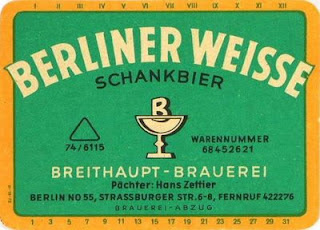Wort was run off the mash tun and cooled to just 45-47º C when it was pitched with a pure culture of lactobacillus delbruckii. Due to the warm temperature this quickly soured the wort. After five to seven hours the wort had reached a lactic acid content of 0.16-0.20%. This level of sourness was enough for the flavour, but not enough to interfere with the yeast fermentation, which could happen at higher concentrations. The wort was then boiled, cooled and pitched with yeast.
After primary fermentation the beer was handled in the usual way. It was bottled and stored in cool cellars to allow bottle conditioning.
"Important Question for Breweries which produce Acid Beers of the Type of Berlin " Weiss" Beer. 0. Francke (Wochensch. Brau., 1907, 24, 621—624).—"Weiss" beer is prepared by fermenting wort with yeast and lactic acid bacteria. It is a very difficult matter, however, to acclimatise a mixture of lactic acid bacteria and pure yeast in constant proportions. The author recommends a process (which has been employed for two years with very satisfactory results) in which the lactic acid and yeast fermentations are carried out separately. The wort, as it runs off from the spent grains, is subjected to the action of pure culture lactic acid bacteria until the required degree of acidity is attained. The wort is then boiled, cooled, and fermented with pure culture yeast. The beer thus prepared has a pleasant acid taste, and does not require the aid of certain non-slime forming pediococci (see this Journal, 1907, 13, 626—630) to impart a pleasant flavour to it. If a mature, vinous " Weiss " beer is required, it is only necessary to treat the lactic acid-containing wort with ordinary bacteria-containing " Weiss " beer yeast. The presence of the lactic acid protects the fermenting wort against the attack of dangerous pediococci, and the beer acquires a sound, vinous taste. The beer prepared by the first method (i.e., that in which the lactic acid fermentation is followed by a pure yeast fermentation) only requires a short period of storage before it is ready for consumption. For the lactic acidification, the author employs distillery culture lactic acid bacillus Delbrucki, and for the alcoholic fermentation, top-fermentation pure yeast, Race B (high attenuating)."
"Journal of the Institute of Brewing, Volume 14", 1908, pages 196 - 197.
So, rather than going to the trouble of keeping the mixed yeast/lactic acid bacteria culture in balance, you ferment first with the bacteria, then with the yeast.
The method was abandoned after 2 years because beer brewed this way didn’t acquire the typical Berliner Weisse flavour. The explanation was simple: no Brettanomyces was involved. At the time no-one was aware of its crucial role in the flavour development of the style.












































































2 comments:
Great stuff, this has been a very interesting series on BW.
Since brewing with Brett and bacteria can be a lot more unpredictable, I'm curious when making Berliner Weisse if there was much blending with young beer and/or different batches of funkier beer to even out the flavor profiles. Correct me if I'm wrong, but isn't that what the British did when they blended 19th Century young ales with varying amounts of stock ale?
Post a Comment